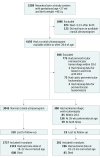Neurodevelopmental and Behavioral Outcomes in Extremely Premature Neonates With Ventriculomegaly in the Absence of Periventricular-Intraventricular Hemorrhage
- PMID: 29181530
- PMCID: PMC5833521
- DOI: 10.1001/jamapediatrics.2017.3545
Neurodevelopmental and Behavioral Outcomes in Extremely Premature Neonates With Ventriculomegaly in the Absence of Periventricular-Intraventricular Hemorrhage
Abstract
Importance: Studies of cranial ultrasonography and early childhood outcomes among cohorts of extremely preterm neonates have linked periventricular-intraventricular hemorrhage and cystic periventricular leukomalacia with adverse neurodevelopmental outcomes. However, the association between nonhemorrhagic ventriculomegaly and neurodevelopmental and behavioral outcomes is not fully understood.
Objective: To characterize the outcomes of extremely preterm neonates younger than 27 weeks' gestational age who experienced nonhemorrhagic ventriculomegaly that was detected prior to 36 weeks' postmenstrual age.
Design, setting, and participants: This longitudinal observational study was conducted at 16 centers of the Eunice Kennedy Shriver National Institute of Child Health and Human Development Neonatal Research Network. Infants born prior to 27 weeks' gestational age in any network facility between July 1, 2006, and June 30, 2011, were included if they had a cranial ultrasonogram performed prior to 36 weeks' postmenstrual age. Comparisons were made between those with ventriculomegaly and those with normal cranial sonograms. Data analysis was completed from August 2013 to August 2017.
Main outcomes and measures: The main outcome was neurodevelopmental impairment, defined as a Bayley Scales of Infant and Toddler Development III cognitive score less than 70, moderate/severe cerebral palsy, a Gross Motor Function Classification System score of level 2 or more, vision impairment, or hearing impairment. Secondary outcomes included Bayley Scales of Infant and Toddler Development III subscores, components of neurodevelopmental impairment, behavioral outcomes, and death/neurodevelopmental impairment. Logistic regression was used to evaluate the association of ventriculomegaly with adverse outcomes while controlling for potentially confounding variables and center differences as a random effect. Linear regression was used similarly for continuous outcomes.
Results: Of 4193 neonates with ultrasonography data, 300 had nonhemorrhagic ventriculomegaly (7%); 3045 had normal cranial ultrasonograms (73%), 775 had periventricular-intraventricular hemorrhage (18.5%), and 73 had cystic periventricular leukomalacia (1.7%). Outcomes were available for 3008 of 3345 neonates with ventriculomegaly or normal scans (90%). Compared with normal cranial ultrasonograms, ventriculomegaly was associated with lower gestational age, male sex, and bronchopulmonary dysplasia, late-onset sepsis, meningitis, necrotizing enterocolitis, and stage 3 retinopathy of prematurity. After adjustment, neonates with ventriculomegaly had higher odds of neurodevelopmental impairment (odds ratio [OR], 3.07; 95% CI, 2.13-4.43), cognitive impairment (OR, 3.23; 95% CI, 2.09-4.99), moderate/severe cerebral palsy (OR, 3.68; 95% CI, 2.08-6.51), death/neurodevelopmental impairment (OR, 2.17; 95% CI, 1.62-2.91), but not death alone (OR, 1.09; 95% CI, 0.76-1.57). Behavioral outcomes did not differ.
Conclusions and relevance: Nonhemorrhagic ventriculomegaly is associated with increased odds of neurodevelopmental impairment among extremely preterm neonates.
Conflict of interest statement
Figures
Comment in
-
Does ventriculomegaly without hemorrhage impact neurologic and behavioral outcomes of premature neonates?J Perinatol. 2019 Nov;39(11):1577-1580. doi: 10.1038/s41372-019-0492-9. Epub 2019 Sep 5. J Perinatol. 2019. PMID: 31488905 No abstract available.
References
-
- Miller SP, Ferriero DM, Leonard C, et al. . Early brain injury in premature newborns detected with magnetic resonance imaging is associated with adverse early neurodevelopmental outcome. J Pediatr. 2005;147(5):609-616. - PubMed
-
- Inder TE, Wells SJ, Mogridge NB, Spencer C, Volpe JJ. Defining the nature of the cerebral abnormalities in the premature infant: a qualitative magnetic resonance imaging study. J Pediatr. 2003;143(2):171-179. - PubMed
-
- Payne AH, Hintz SR, Hibbs AM, et al. ; Eunice Kennedy Shriver National Institute of Child Health and Human Development Neonatal Research Network . Neurodevelopmental outcomes of extremely low-gestational-age neonates with low-grade periventricular-intraventricular hemorrhage. JAMA Pediatr. 2013;167(5):451-459. - PMC - PubMed
Publication types
MeSH terms
Grants and funding
LinkOut - more resources
Full Text Sources
Other Literature Sources
Medical


